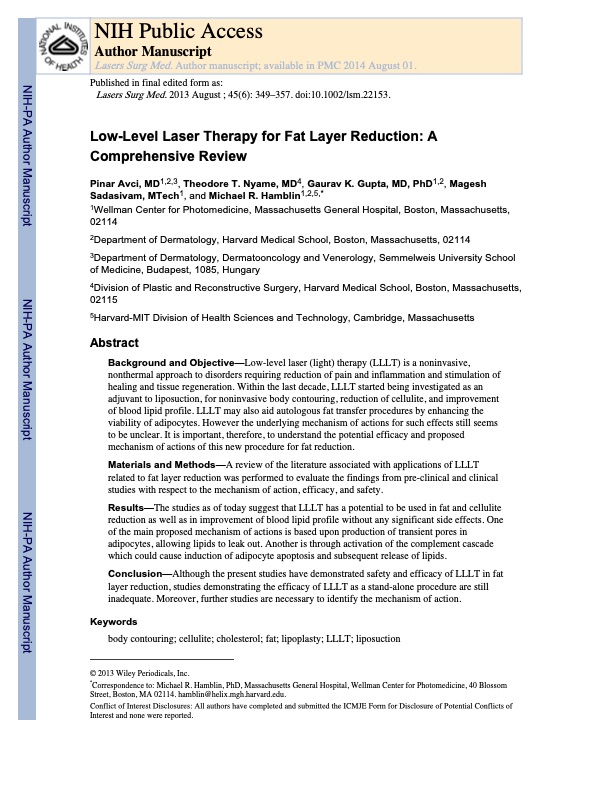
PDF Publication Title:
Text from PDF Page: 001
NIH Public Access Author Manuscript Lasers Surg Med. Author manuscript; available in PMC 2014 August 01. Published in final edited form as: Lasers Surg Med. 2013 August ; 45(6): 349–357. doi:10.1002/lsm.22153. Low-Level Laser Therapy for Fat Layer Reduction: A Comprehensive Review Pinar Avci, MD1,2,3, Theodore T. Nyame, MD4, Gaurav K. Gupta, MD, PhD1,2, Magesh Sadasivam, MTech1, and Michael R. Hamblin1,2,5,* 1Wellman Center for Photomedicine, Massachusetts General Hospital, Boston, Massachusetts, 02114 2Department of Dermatology, Harvard Medical School, Boston, Massachusetts, 02114 3Department of Dermatology, Dermatooncology and Venerology, Semmelweis University School of Medicine, Budapest, 1085, Hungary 4Division of Plastic and Reconstructive Surgery, Harvard Medical School, Boston, Massachusetts, 02115 5Harvard-MIT Division of Health Sciences and Technology, Cambridge, Massachusetts Abstract Background and Objective—Low-level laser (light) therapy (LLLT) is a noninvasive, nonthermal approach to disorders requiring reduction of pain and inflammation and stimulation of healing and tissue regeneration. Within the last decade, LLLT started being investigated as an adjuvant to liposuction, for noninvasive body contouring, reduction of cellulite, and improvement of blood lipid profile. LLLT may also aid autologous fat transfer procedures by enhancing the viability of adipocytes. However the underlying mechanism of actions for such effects still seems to be unclear. It is important, therefore, to understand the potential efficacy and proposed mechanism of actions of this new procedure for fat reduction. Materials and Methods—A review of the literature associated with applications of LLLT related to fat layer reduction was performed to evaluate the findings from pre-clinical and clinical studies with respect to the mechanism of action, efficacy, and safety. Results—The studies as of today suggest that LLLT has a potential to be used in fat and cellulite reduction as well as in improvement of blood lipid profile without any significant side effects. One of the main proposed mechanism of actions is based upon production of transient pores in adipocytes, allowing lipids to leak out. Another is through activation of the complement cascade which could cause induction of adipocyte apoptosis and subsequent release of lipids. Conclusion—Although the present studies have demonstrated safety and efficacy of LLLT in fat layer reduction, studies demonstrating the efficacy of LLLT as a stand-alone procedure are still inadequate. Moreover, further studies are necessary to identify the mechanism of action. Keywords body contouring; cellulite; cholesterol; fat; lipoplasty; LLLT; liposuction © 2013 Wiley Periodicals, Inc. *Correspondence to: Michael R. Hamblin, PhD, Massachusetts General Hospital, Wellman Center for Photomedicine, 40 Blossom Street, Boston, MA 02114. hamblin@helix.mgh.harvard.edu. Conflict of Interest Disclosures: All authors have completed and submitted the ICMJE Form for Disclosure of Potential Conflicts of Interest and none were reported. NIH-PA Author Manuscript NIH-PA Author Manuscript NIH-PA Author ManuscriptPDF Image | Low-Level Laser Therapy for Fat Layer Reduction

PDF Search Title:
Low-Level Laser Therapy for Fat Layer ReductionOriginal File Name Searched:
nihms-509305.pdfDIY PDF Search: Google It | Yahoo | Bing
Cruise Ship Reviews | Luxury Resort | Jet | Yacht | and Travel Tech More Info
Cruising Review Topics and Articles More Info
Software based on Filemaker for the travel industry More Info
The Burgenstock Resort: Reviews on CruisingReview website... More Info
Resort Reviews: World Class resorts... More Info
The Riffelalp Resort: Reviews on CruisingReview website... More Info
| CONTACT TEL: 608-238-6001 Email: greg@cruisingreview.com | RSS | AMP |